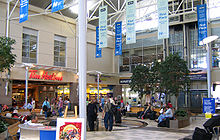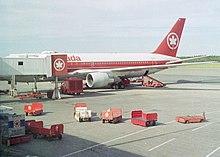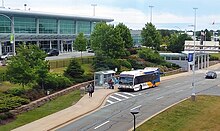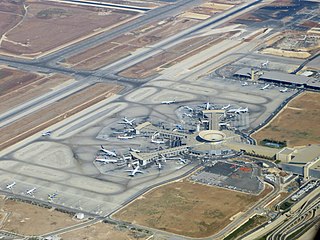
Ben Gurion International Airport, commonly known by the Hebrew-language acronym Natbag, is the main international airport of Israel. Situated on the northern outskirts of the city of Lod, it is the busiest airport in the country. It is located 45 kilometres (28 mi) to the northwest of Jerusalem and 20 kilometres (12 mi) to the southeast of Tel Aviv. Until 1973, it was known as Lod Airport, whereafter it was renamed in honour of David Ben-Gurion (1886–1973), the first Israeli prime minister. The airport serves as a hub for El Al, Israir Airlines, Arkia, and Sun d'Or, and is managed by the Israel Airports Authority.
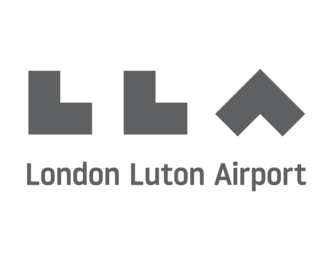
London Luton Airport is an international airport located in Luton, Bedfordshire, England, situated 1.7 miles (2.7 km) east of the town centre, and 29 miles (47 km) north of Central London. The airport is owned by London Luton Airport Ltd (LLAL), a company wholly owned by Luton Borough Council, and operated by London Luton Airport Operations Ltd (LLAOL).

Québec City Jean Lesage International Airport, also known as Jean Lesage International Airport, is the primary airport serving Quebec City, Canada. Designated as an international airport by Transport Canada, it is located eleven kilometres west-southwest of the city. In 2023, it was the 12th-busiest airport in Canada, with 1,688,736 passengers. More than 10 airlines offer 360 weekly flights to destinations across Canada, the United States, Central America, Mexico, the Caribbean and Europe.

Chhatrapati Shivaji Maharaj International Airport is an international airport serving Mumbai and the Mumbai Metropolitan Region (MMR). It is the second busiest airport in India in terms of total and international passenger traffic after Delhi, and was the ninth busiest airport in Asia and 25th busiest airport in the world by passenger traffic in fiscal year 2023-24.

L.F. Wade International Airport, formerly named Bermuda International Airport, is the sole airport serving the British overseas territory of Bermuda in the north Atlantic Ocean. It is located in the parish of St. George's and is 6 nautical miles northeast of Bermuda's capital, Hamilton. In 2016, the airport handled 402,925 passengers, up 5.6% from 2006. It has one passenger terminal, one cargo terminal, eight aircraft stands and can support all aircraft sizes up to and including the Airbus A380. Currently, nine passenger or cargo airlines operate seasonal or year-round scheduled services from the Azores, Canada, the United Kingdom, and the United States. The airport covers 536 acres of land and contains one runway.

Calgary International Airport, branded as YYC Calgary International Airport, is an international airport that serves the city of Calgary, Alberta, Canada. It is located approximately 17 kilometres (11 mi) northeast of downtown and covers an area of 20.82 square kilometres. With 18.5 million passengers in 2023 and 124,108 aircraft movements in 2021, Calgary International is the busiest airport in Alberta and the fourth-busiest in Canada by passenger traffic. This airport is served by the Calgary International Airport Emergency Response Service for aircraft rescue and firefighting (ARFF) protection. The region's petroleum and tourism industries have helped foster growth at the airport, which has nonstop flights to an array of destinations in North and Central America, Europe, and Asia. Calgary serves as the headquarters and primary hub for WestJet.

Jazz Aviation LP, commonly shortened to Jazz, is a Canadian regional airline based at Halifax Stanfield International Airport, in Enfield, Halifax, Nova Scotia, and is a wholly owned subsidiary of Chorus Aviation. Jazz Aviation provides regional and charter airline services in Canada and the United States, primarily under contract to Air Canada using the brand name Air Canada Express, and also as Jazz Charters.
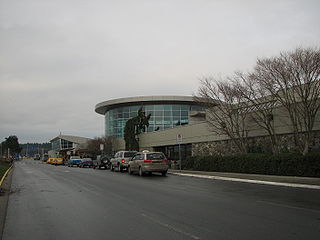
Victoria International Airport serves Victoria, British Columbia, Canada. It is 12 nautical miles north northwest of Victoria on the Saanich Peninsula, with the bulk of the airport in North Saanich, and a small portion of the airfield extending into Sidney. The airport is run by the Victoria Airport Authority. YYJ has many nonstop daily flights to Vancouver International Airport, which is a major airport serving many global routes. Additionally, Victoria International has nonstop service to Seattle (SEA), Toronto (YYZ), Montreal, Calgary (YYC), Edmonton (YEG), and several smaller cities in British Columbia and Yukon. The airport also has seasonal nonstop service to several Mexican resort destinations. Non-stop service between Victoria and the United States decreased by 50% at the beginning of September 2019 when Delta Airlines permanently ended its three daily flights to Seattle, after which only Alaska Airlines continued to fly the route.

Francisco Bangoy International Airport, also commonly known as Davao International Airport, is the main airport serving Davao City and Davao Region in the Philippines. Serving as the main gateway to Mindanao, it is the busiest airport on the island and the third busiest in the Philippines in 2022.

Bagdogra Airport is a customs airport serving the city of Siliguri in West Bengal, India. It is located in Bagdogra, 12 km (7.5 mi) south-west from the city centre. It is operated as a civil enclave at Bagdogra Air Force Station of the Indian Air Force. It is the gateway to the hill stations of Darjeeling, Gangtok, Kurseong, Kalimpong, Mirik and other parts of North Bengal region. Siliguri, being a major transport and economic hub, the airport sees thousands of travellers and tourists annually. The Government of India conferred limited international airport status to the airport in 2002 with limited international operations to Bangkok–Suvarnabhumi and Paro. This is the second busiest airport in West Bengal.

Iqaluit Airport serves Iqaluit, Nunavut, Canada and is located adjacent to the city. It hosts scheduled passenger service from Ottawa, Montreal, Rankin Inlet, and Kuujjuaq on carriers such as Canadian North, and from smaller communities throughout eastern Nunavut. It is also used as a forward operating base by the Royal Canadian Air Force (RCAF). In 2011, the terminal handled more than 120,000 passengers.

Flamingo International Airport, also called Bonaire International Airport, is an international airport located near Kralendijk on the island of Bonaire in the Caribbean Netherlands. It was once the hub for BonaireExel and CuraçaoExel before they were rebranded as Dutch Antilles Express, and served as a secondary hub for Dutch Antilles Express and Insel Air. The airport is the fourth largest in the Dutch Caribbean, after Queen Beatrix International Airport on Aruba, Princess Juliana International Airport on Sint Maarten and Curaçao International Airport on Curaçao and is now the largest airport in the Caribbean Netherlands, with F. D. Roosevelt Airport in Sint Eustatius being the second largest and Juancho E. Yrausquin Airport in Saba being the smallest.

Tribhuvan International Airport is an international airport located in Kathmandu, Bagmati, Nepal. It has a tabletop runway, a domestic terminal and an international terminal. As the country's main international airport, it connects Nepal to over 40 destinations in 17 countries.

Punta Cana International Airport is a privately owned commercial airport in Punta Cana, eastern Dominican Republic. The airport was built with open-air terminals and roofs covered in palm fronds. Grupo Punta Cana built the airport, which was designed by architect Oscar Imbert, and inaugurated it in December 1983. It is owned by Grupo Punta Cana and became the first privately owned international airport in the world.
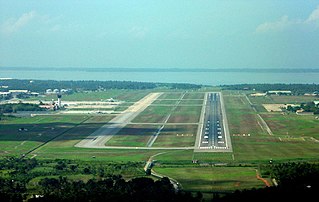
Bandaranaike International Airport (BIA) (Sinhala: බණ්ඩාරනායක ජාත්යන්තර ගුවන්තොටුපළ, romanized: Bandāranāyaka Jātyantara Guvantoṭupaḷa; Tamil: பண்டாரநாயக்க சர்வதேச விமான நிலையம், romanized: Paṇṭāranāyakka Carvatēca Vimāṉa Nilaiyam) (commonly known as Colombo International Airport, Colombo–Bandaranaike International Airport, and locally as Katunayake International Airport) (IATA: CMB, ICAO: VCBI) is the main international airport serving Sri Lanka. It is named after former Prime Minister S. W. R. D. Bandaranaike (1899–1959) and is in the suburb of Negombo, 32.5 kilometres (20+1⁄4 miles) north of the nation's capital and commercial center, Colombo.
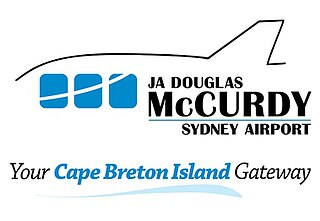
JA Douglas McCurdy Sydney Airport is a regional airport located in Reserve Mines in the Canadian province of Nova Scotia. The airport serves the Cape Breton Regional Municipality (CBRM) and the surrounding areas of Cape Breton Island. McCurdy Sydney Airport has the distinction of being the oldest public airport in Nova Scotia, first licensed on August 3, 1929.

Bengaluru Airport, officially Kempegowda International Airport, is an international airport serving Bangalore, the capital of Karnataka, India. Spread over 4,000 acres (1,600 ha), it is located about 35 kilometres (22 mi) north of the city near the suburb of Devanahalli. It is owned and operated by Bengaluru International Airport Limited (BIAL), a public–private consortium. The airport opened in May 2008 as an alternative to increased congestion at HAL Airport, the original primary commercial airport serving the city. It is named after Kempe Gowda I, the founder of Bangalore. Kempegowda International Airport became Karnataka's first fully solar powered airport, developed by CleanMax Solar.

Juanda International Airport, is an international airport located in Sedati, Sidoarjo, East Java, Indonesia. It is now the third busiest airport in Indonesia. This airport is located approximately 12 kilometers (7.5 mi) from Downtown Surabaya and serves the Surabaya metropolitan area, the metropolitan area of Surabaya plus extended urban area. Juanda International Airport is operated by PT Angkasa Pura I. The airport takes its name after Djuanda Kartawidjaja (1911–1963), the last Prime Minister of Indonesia who had suggested development of this airport. In 2019, the airport served about 500 aircraft per day.

Mangalore International Airport is an international airport serving the coastal city of Mangalore, India. It is one of only two international airports in Karnataka, the other being Kempegowda International Airport, Bangalore. Mangalore International Airport is the second busiest airport in Karnataka. In addition to domestic destinations, flights depart daily for major cities in the Middle East. The airport was named Bajpe Aerodrome, when it opened on 25 December 1951 by former Prime Minister Jawaharlal Nehru who arrived on a Douglas DC-3 aircraft.

Mactan–Cebu International Airport is an international airport serving Cebu and serves as the main gateway to the Central Visayas region in the Philippines. Located on a 797-hectare (1,970-acre) site in Lapu-Lapu City on Mactan, it is the second busiest airport in the Philippines. Opened on April 27, 1966, the airport serves as a hub for Philippine Airlines, and as an operating base for Cebu Pacific and Philippines AirAsia.







